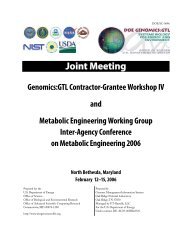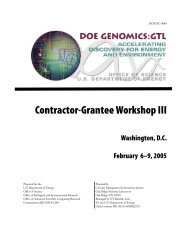Joint Meeting - Genomics - U.S. Department of Energy
Joint Meeting - Genomics - U.S. Department of Energy
Joint Meeting - Genomics - U.S. Department of Energy
You also want an ePaper? Increase the reach of your titles
YUMPU automatically turns print PDFs into web optimized ePapers that Google loves.
28<br />
Systems Biology for DOE <strong>Energy</strong> and Environmental Missions<br />
transcripts under these conditions [1]. Indeed, anoxia<br />
leads to the up-regulation <strong>of</strong> genes encoding proteins<br />
involved in fermentation and more specifically those<br />
associated with pyruvate catabolism, such as pyruvate<br />
formate lyase (PFL1) and pyruvate:ferredoxin oxidoreductase<br />
(PRF1). Moreover, increased levels <strong>of</strong> transcripts<br />
encoding several regulatory elements suggest that activation<br />
<strong>of</strong> specific signalling pathways and the need to control<br />
translational and post-translational processes occur in<br />
the cells as the environment becomes anoxic.<br />
In this study we have compared metabolic and regulatory<br />
acclimation responses that accompany anaerobiosis in<br />
wild-type cells and in a mutant defective for H 2 production<br />
as a consequence <strong>of</strong> a null mutation in the [FeFe]hydrogenase<br />
maturation protein, HYDEF [2]. The<br />
mutant exhibits both elevated accumulation <strong>of</strong> succinate<br />
and diminished production <strong>of</strong> CO 2 , relative to the parental<br />
strain, after four hours <strong>of</strong> dark, anaerobic acclimation.<br />
These results are consistent with increased activity <strong>of</strong><br />
enzymes required for anoxic succinate production, and a<br />
decreased metabolic flux through the PRF1 pathway. In<br />
the absence <strong>of</strong> hydrogenase activity, an increase in succinate<br />
suggests the need to activate alternative pathways<br />
to metabolize pyruvate and re-oxidize NAD(P)H, which<br />
allows continued glycolysis and fermentation in the<br />
absence <strong>of</strong> O 2 . Activities required for succinate production<br />
include pyruvate carboxylation and/or oxaloacetate<br />
reduction, which generate malate. Malate can then be<br />
further metabolized to fumarate and finally to succinate.<br />
Enzymes that can potentially catalyze the carboxylation<br />
<strong>of</strong> pyruvate to malate via independent pathways are<br />
the pyruvate carboxylase and malic enzymes. Marked<br />
increases in the abundance <strong>of</strong> mRNAs encoding both <strong>of</strong><br />
these enzymes are observed in the mutant relative to the<br />
parental strain. Chlamydomonas has a single gene encoding<br />
pyruvate carboxylase and six genes encoding putative<br />
malic enzymes. Only one <strong>of</strong> the malic enzyme genes,<br />
MME4, shows a dramatic increase in expression (mRNA<br />
abundance) in the hydEF-1 mutant during anaerobiosis.<br />
Furthermore, there are also large increases in transcripts<br />
encoding fumarase and fumarate reductase, the enzymes<br />
required for the conversion <strong>of</strong> malate to succinate. To further<br />
identify potential metabolic and regulatory features<br />
<strong>of</strong> the hydEF-1 mutant relative to the parental strain,<br />
we used a high density, oligonucleotide (70-mer)-based<br />
microarray to compare genome-wide transcript patterns<br />
<strong>of</strong> hydEF-1 and parental strains after transferring cultures<br />
from aerobic to anaerobic conditions. Several transcripts<br />
encoding proteins associated with cellular redox functions<br />
and other aspects <strong>of</strong> anaerobic metabolism were observed<br />
to be differentially regulated in the mutant under anaerobic<br />
conditions.<br />
* Presenting author<br />
In summary, these experiments illustrate the marked<br />
metabolic flexibility <strong>of</strong> Chlamydomonas and also provide<br />
insights into how mutants, altered in normal H 2 metabolism,<br />
acclimate to H 2 -producting conditions. Moreover<br />
the information obtained will provide the foundation for<br />
metabolic engineering and accurate in silico modelling<br />
<strong>of</strong> Chlamydomonas metabolism. The availability <strong>of</strong> the<br />
Chlamydomonas genome sequence, combined with highthroughput-‘omics’-based<br />
approaches is critical in this<br />
effort. Moreover, the use <strong>of</strong> specific mutant strains can<br />
help establish the foundation for a more comprehensive<br />
understanding <strong>of</strong> metabolic networks, how cells adjust<br />
metabolite fluxes when specific metabolic reactions are<br />
blocked, and how to improve H 2 -production yields.<br />
References<br />
1. ,<br />
2.<br />
Mus, F., A. Dubini, M. Seibert M.C. Posewitz and<br />
A.R. Grossman. (2007) “Anaerobic acclimation in<br />
Chlamydomonas reinhardtii: Anoxic gene expression,<br />
hydrogenase induction and metabolic pathways”, J.<br />
Biol. Chem. 282 (35), 25475-25486.<br />
Posewitz, M. C., P. W. King, S. L. Smolinski, L.<br />
Zhang, M. Seibert, and Maria L. Ghirardi (2004)<br />
“Discovery <strong>of</strong> Two Novel Radical SAM Proteins<br />
Required for the Assembly <strong>of</strong> an Active [Fe]-<br />
Hydrogenase,” J. Biol. Chem. 279, 25711-25720.<br />
33<br />
Development <strong>of</strong> Biologically Based<br />
Assays to Study Rate-Limiting Factors<br />
in Algal Hydrogen Photoproduction<br />
Alexandra Dubini, Matt Wecker, and Maria L.<br />
Ghirardi* (maria_ghirardi@nrel.gov)<br />
GTL<br />
National Renewable <strong>Energy</strong> Laboratory, Golden,<br />
Colorado<br />
Photobiological H production from water is a clean,<br />
2<br />
non-polluting and renewable technology. Although the<br />
potential light conversion efficiency to H by biological<br />
2<br />
organisms is theoretically high (about 10%), the system<br />
is currently limited by biochemical and engineering<br />
constraints. These limitations include (but are not<br />
restricted to) the extreme O sensitivity <strong>of</strong> the biological<br />
2<br />
hydrogenases and the low availability <strong>of</strong> reductants to the<br />
hydrogenase due to the existence <strong>of</strong> competing metabolic<br />
pathways. Our research addresses the O sensitivity issue<br />
2<br />
by developing a new, biologically-based assay to screen<br />
large microbial populations for improved H -production<br />
2<br />
properties. This novel assay is based on the H -sensing<br />
2<br />
properties <strong>of</strong> systems found in nitrogenase-containing





